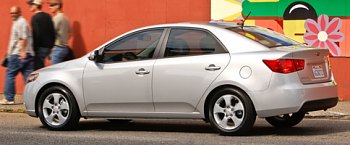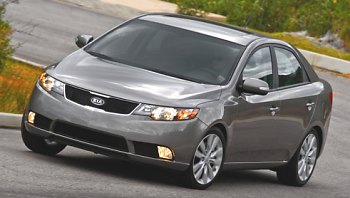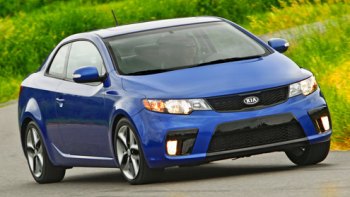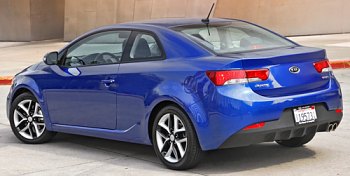KIA Forte
Debut: 2009 |
||||||||
Not many manufacturers can afford to build two cars for the C-segment. The fast-rising KIA is one of them. For European market, it has C'eed. For America, Asia and rest of the world, it has Forte (although Australia and New Zealand call it Cerato instead). Both cars have a lot of commonalities, such as the same 2650 mm wheelbase, but also quite a lot of differences. While C'eed is a hatchback, Forte is a conventional 3-box sedan. C'eed has a sophisticated multi-link rear suspension to please the demanding European drivers, while Forte can be equipped with larger engines to please the torque-hungry American. They even differ in the place of manufacture: C'eed is built in Czech Republic while Forte is produced back in South Korea. Nevertheless, both cars guarantee the same excellent value for money. Forte is a good looking car. It was designed in the company's California studio under the guidance of Peter Schreyer, who left Audi and Volkswagen to head the design activity of KIA. Asian car design usually falls into one of these two camps - boring or flamboyant. Examples are Toyota Corolla / Auris, Nissan Bluebird Sylphy / Tiida / Sentra for the former and Mazda 3, Honda Civic and Mitsubishi Lancer for the latter. The valuable experience of Peter Schreyer brought KIA a rare sense of design maturity. It might not be as striking as some European designs from Ford, Citroen or SEAT, it is undeniably a balanced, high-quality and inoffending design. I particularly like its wedge shape, its headlamps and front fenders, which are very original. Its drag coefficient at 0.29 is also excellent for the class.
Compared to the exterior, the interior design is rather ordinary. While it is far better looking and touching than the outgoing Cerato, it does not raise your interest like most European family hatches do. Although most plastic surfaces are grained, none of them are soft-touch. The hard steering wheel and gearstick feel cheap, as is the faux alloy trim on the center console of top model. The door panels simply look low rent. That said, to sit and travel this cabin is hard to fault. Its long wheelbase guarantees plenty of room front and rear, especially because the floor is flat. Seat comfort and driving position adjustment are faultless. Besides, in the tradition of Korean cars it provides plenty of standard equipments that normally reserved as options in rivals. At the back, you get a decent boot space at 415 liters. The chassis of Forte is fairly conventional. 63 percent of its monocoque is made of high-strength steel in order to improve rigidity and crash worthiness without adding weight. NVH engineering follows the modern route to employ a subframe for mounting the front MacPherson strut suspensions. The rear is suspended by a torsion-beam axle. Electrical power steering, all-wheel disc brakes, ABS and stability control complete the picture.
There are four engines on offer. 128hp 1.6-liter common-rail turbo diesel, 124hp 1.6-liter VVT petrol, 156hp 2.0-liter VVT petrol and 173hp 2.4-liter dual-VVT petrol. The last two come from the "World Engine" family developed jointly with Mitsubishi and Chrysler. The large 2.4-liter engine is offered only for the North American market because elsewhere few people could afford its extra thirst. In the rest of the world, most sales are likely to concentrate on the two 1.6-liter engines, which are not offered in North America. Among them, the common-rail turbo diesel is more lovely for its strong performance, refinement and frugality. The 1.6 petrol is not short of power, but it needs rev to realize that, and it is noisy to do so. The 2.0-liter petrol is more refined, if not feeling particularly gusty. If you want instant torque, the long-stroke 2.4-liter will be a must. It is also the only engine here pairs with a 6-speed manual gearbox or 5-speed automatic. Other engines are provided with either 5-speed manual or 4-speed auto. A 2.4-liter Forte with 6-speed manual can take you from standstill to 60 mph under 8 seconds. That is the territory of warm hatches.
Nevertheless, it lacks a chassis tuning to match. While the Forte steers and rides well enough for a family car, it is by no means entertaining. At first you may be pleased with its firm yet absorbent ride, which simulates European cars. However, rides over really broken surfaces and it instantly shows why a torsion-beam suspension can never replace an independent multi-link. Admittedly, its poorly sorted damping is also a major reason for its poor low-speed ride. Up the pace on back roads, the initial feeling of nice body control fades out quickly. You will beg for less body roll, more grip, sharper throttle response and a steering that really communicates with the black top. If you are keen drivers, you will be far better catered in a Mazda 3, Ford Focus or Volkswagen Golf, or even another KIA called C'eed. |
||||||||
| The above report was last updated on 11 Jul 2009. All Rights Reserved. |







 Forte 1.6
Forte 1.6 Hide all
Hide all
